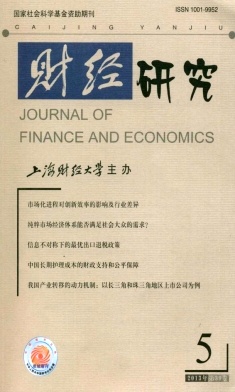我国产业转移的动力机制:以长三角和珠三角地区上市公司为例
财经研究 2013 年 第 39 卷第 05 期, 页码:100 - 112
摘要
参考文献
摘要
文章基于长三角和珠三角地区312家工业上市公司2000-2010年在国内30个省份的投资数据,将地区和企业层面特征综合纳入同一个研究框架,分别使用Logit和Tobit模型从本土企业微观层面揭示了我国产业转移的动力机制。研究结果表明:(1)要素成本、市场需求、集聚外部性、对外开放水平、市场发育程度、企业规模是影响我国产业转移的决定性因素,而企业利润率、资本结构则不是决定性因素;(2)集聚外部性对产业转移的影响较小,尚未充分发挥产业集聚的引资效应;(3)靠近国际市场的地理区位优势和发育完善的国内市场需求是当前我国本土企业对内投资的主要动力;(4)大规模企业比小规模企业具有更强的转移意愿。
[1]陈建军.中国现阶段的产业区域转移的实证研究——结合浙江105家企业的问卷调查报告的分析[J].管理世界,2002,(6):64-74.
[2]范剑勇,谢强强.地区间产业分布的本地市场效应及其对区域协调发展的启示[J].经济研究,2010,(4):107-119.
[3]符正平,曾素英.集群产业转移中的转移模式与行动特征——基于企业社会网络视角的分析[J].管理世界,2008,(12):83-92.
[4]刘志彪.重构国家价值链:转变中国制造业发展方式的思考[J].世界经济与政治论坛,2011,(4):1-16.
[5]张杰,刘志彪.全球化背景下国家价值链的构建与中国企业升级[J].经济管理,2009,(2):21-25.
[6]张少军,刘志彪.全球价值链模式的产业转移—动力、影响与对中国产业升级和区域协调发展的启示[J].中国工业经济,2009,(11):5-15.
[7]Brouwer A E,Mariotti I,van Ommeren J N.The firm relocation decision:An empiricalinvestigation[J].The Annals of Regional Science,2004,38(2):335-347.
[8]Cheng S,Stough R.Location decisions of Japanese new manufacturing plants in China:A discrete-choice analysis[J].Annals of Regional Science,2006,40(2):369-387.
[9]Costinot A.A comparative institutional analysis of agreements on product standards[J].Journal of International Economics,2008,75(1):197-213.
[10]Figueiredo O,Guimaraes P,Woodward D.Home-field advantage:Location decisionsof Portuguese entrepreneurs[J].Journal of Urban Economics,2002,52(2):341-361.
[11]Fujita M,Thisse J F.Economics of agglomeration:Cities,industrial location,and re-gional growth[M].Cambridge:Cambridge University Press,2002.
[12]Inomata S.A new measurement for international fragmentation of the production..process:An international input-output approach[R]IDE Discussion Paper No.175,2008.
[13]Jones R.Immigration vs.outsourcing:Effects on labor markets[J].International Re-view of Economics and Finance,2005,14(2):105-114.
[14]Kaplinsky R,Morris M.A handbook for value chain research[C].Paper for IDRC,2002.
[15]Katayama S,Lahiri S,Tomiura E.Cost heterogeneity and the destination of Japaneseforeign direct investment:A theoretical and empirical analysis[J].Japan and the WorldEconomy,2011,23(3):170-177.
[2]范剑勇,谢强强.地区间产业分布的本地市场效应及其对区域协调发展的启示[J].经济研究,2010,(4):107-119.
[3]符正平,曾素英.集群产业转移中的转移模式与行动特征——基于企业社会网络视角的分析[J].管理世界,2008,(12):83-92.
[4]刘志彪.重构国家价值链:转变中国制造业发展方式的思考[J].世界经济与政治论坛,2011,(4):1-16.
[5]张杰,刘志彪.全球化背景下国家价值链的构建与中国企业升级[J].经济管理,2009,(2):21-25.
[6]张少军,刘志彪.全球价值链模式的产业转移—动力、影响与对中国产业升级和区域协调发展的启示[J].中国工业经济,2009,(11):5-15.
[7]Brouwer A E,Mariotti I,van Ommeren J N.The firm relocation decision:An empiricalinvestigation[J].The Annals of Regional Science,2004,38(2):335-347.
[8]Cheng S,Stough R.Location decisions of Japanese new manufacturing plants in China:A discrete-choice analysis[J].Annals of Regional Science,2006,40(2):369-387.
[9]Costinot A.A comparative institutional analysis of agreements on product standards[J].Journal of International Economics,2008,75(1):197-213.
[10]Figueiredo O,Guimaraes P,Woodward D.Home-field advantage:Location decisionsof Portuguese entrepreneurs[J].Journal of Urban Economics,2002,52(2):341-361.
[11]Fujita M,Thisse J F.Economics of agglomeration:Cities,industrial location,and re-gional growth[M].Cambridge:Cambridge University Press,2002.
[12]Inomata S.A new measurement for international fragmentation of the production..process:An international input-output approach[R]IDE Discussion Paper No.175,2008.
[13]Jones R.Immigration vs.outsourcing:Effects on labor markets[J].International Re-view of Economics and Finance,2005,14(2):105-114.
[14]Kaplinsky R,Morris M.A handbook for value chain research[C].Paper for IDRC,2002.
[15]Katayama S,Lahiri S,Tomiura E.Cost heterogeneity and the destination of Japaneseforeign direct investment:A theoretical and empirical analysis[J].Japan and the WorldEconomy,2011,23(3):170-177.
引用本文
桑瑞聪, 刘志彪, 王亮亮. 我国产业转移的动力机制:以长三角和珠三角地区上市公司为例[J]. 财经研究, 2013, 39(5): 100–112.
导出参考文献,格式为:





 6823
6823  3132
3132

